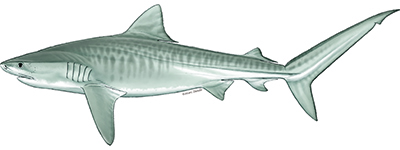Tiger Shark
Galeocerdo cuvier

The tiger shark Galeocerdo cuvier was once a common coastal shark of the Virginia region, but its abundance declined markedly from the 1970s into the 1990s.
Maximum Size
The maximum length attained by adult tiger sharks is about 18 feet (5.5 m) for females and 12.1 feet (3.7 m) for males. Most adults are less than 13 feet (400 cm).
Range
Found in nearly all warm temperate and tropical waters. Occasional visitors to Virginia waters and are usually found at least 10-20 miles offshore.The majority of individuals that occur in the region are sub-adults and adults; the juveniles are born farther south and remain there during their first years.
Diet
Opportunistic feeders, feeding on bony fishes, sharks, rays, sea turtles, sea snakes, sea birds, marine mammals, carrion, and garbage.
Depth Range
Found close inshore, in water ranging from 3 feet (1 meter) to at least 500 feet (150 meters). Found most commonly in waters about 60 feet deep.
Ecology
Tend to have a diel cycle of movement, coming inshore at night and moving into deeper waters during the day. This is a prolific species that produces as many as 70 young per litter, although most litters contain about 20-30 pups. Pups are born at about 3 feet (90 cm). A female only gives birth every 3 years. The species grows very fast campared to some other species, maturing in about 8-9 years.
Fishing Interest
Because of its large size, it is a popular target of recreational anglers. Although it is occasionally caught by commercial fishers, the meat and fins have little value, and it is usually released. lt is common both in coastal and offshore, oceanic waters.

